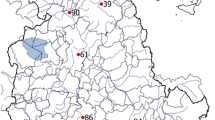Summary
A test of relative homogeneity of annual temperatures at Blue Hill and other stations in the surroundings was carried out by using several statistical criteria. The results indicated that the annual temperatures at Blue Hill were somehow “different” from those of the surrounding stations. To find an explanation of this circumstance several statistical methods, likeStudent's t-test, the significance of the correlation coefficient, etc. were used. The conclusion could be drawn that the annual temperatures at Blue Hill show a different detailed trend from the annual temperatures at the surrounding stations. It was shown also that the trend of annual temperatures differ for stations even not very remote each from other.
Zusammenfassung
Die jährlichen Lufttemperaturen in Blue Hill wurden mit den jährlichen Lufttemperaturen der Stationen in der Umgebung verglichen und so in bezug auf relative Homogenität geprüft; es wurden dabei verschiedene statistische Kriterien angewandt. Das Resultat zeigt, daß die jährlichen Lufttemperaturen in Blue Hill “verschieden”, sind von denen der Umgebung. Um eine Erklärung dafür zu finden, wurden verschiedene statistische Methoden angewandt, wieStudent's t-Test, die Beurteilung des Korrelationskoeffizienten usw. Die Untersuchungen zeigten, daß die jährlichen Lufttemperaturen in Blue Hill einen anderen Detailverlauf aufweisen als in der Umgebung. Dabei ergab sich, daß Stationen trotz verhältnismäßig geringen Entfernungen voneinander einen verschiedenen Verlauf der jährlichen Lufttemperaturen aufweisen können.
Résumé
L'auteur a comparé les moyennes annuelles de la température de l'air à Blue Hill à celles des stations environnantes et en a étudié l'homogénéite relative; il a utilisé à cet effet différents critères. Il en résulte que ces températures annuelles diffèrent de celles des autres stations des environs, ce qui a conduit l'auteur à les étudier par les tests statistiques usuels (testt deStudent, coefficient de corrélation etc.). Ces recherches ont montré que les températures annuelles de Blue Hill ont, dans le détail, un comportement particulier. On a aussi constaté que les températures annuelles de stations relativement peu éloignées varient différemment.
Similar content being viewed by others
References
Victor Conrad: Die klimatischen Elemente und ihre Abhängigkeit von terrestrischen Einflüssen. Handbuch der Klimatologie, herausgegeben vonW. Köppen undR. Geiger. Bd. I, Teil B, pp. 112–115.
Victor Conrad: Homogenitätsbestimmungen meteorologischer Beobachtungsreihen. Meteorol. Z.42, 482 (1925). —Victor Conrad: Die Anwendung desAbbeschen Kriteriums auf geophysikalische Beobachtungsreihen. Gerlands Beitr. Geophys.17, 372–375 (1927). —Victor Conrad: Bemerkungen zur Homogenität der meteorologischen Reihen. Annalen Hydr. u. marit. Meteorologie55, 92–93 (1927).
S. Koller: Graphische Tafeln zur Beurteilung statistischer Zahlen. 3. Aufl. Verl. Dr. D. Steinkopff, Darmstadt 1953.
Additional information
Dedicated to Dr.Victor Conrad to his 80th birthday.
Blue Hill Meteorogical Observatory, Harvard University
With 1 Figure
Now associated with the U. S. Weather Bureau, Washington, D. C.
Rights and permissions
About this article
Cite this article
Putnins, P. The paradox of the “inhomogeneity” of annual temperatures at Blue Hill. Arch. Met. Geoph. Biokl. B. 7, 305–316 (1956). https://doi.org/10.1007/BF02242964
Issue Date:
DOI: https://doi.org/10.1007/BF02242964




